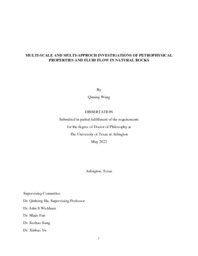
ATTENTION: The works hosted here are being migrated to a new repository that will consolidate resources, improve discoverability, and better show UTA's research impact on the global community. We will update authors as the migration progresses. Please see MavMatrix for more information.
Show simple item record
| dc.creator | Wang, Qiming | |
| dc.date.accessioned | 2023-06-28T15:32:16Z | |
| dc.date.available | 2023-06-28T15:32:16Z | |
| dc.date.created | 2022-05 | |
| dc.date.issued | 2022-05-09 | |
| dc.date.submitted | May 2022 | |
| dc.identifier.uri | http://hdl.handle.net/10106/31386 | |
| dc.description.abstract | Natural rock is one of the most important geological attributes on the Earth that have been widely related to human daily life in various aspects. Rocks are usually utilized with respect to their petrophysical properties and performance within the context of building & construction, petroleum recovery, carbon sequestration, geothermal energy utilization, nuclear waste storage and repositories, and contamination remediation.
Contrary to the well-studied rocks such as sandstone and carbonate rocks, the fluid storage and migration in the tight rock (e.g., shale matrix) is more complex and still poorly understood. Due to the low porosity, extremely low permeability, complex mineral composition, and high degree of spatial heterogeneity of petrophysical properties, the study of shale has been recently attracting an increasing attention. Some studies point out that the fluid flow in shale is strongly restricted by their microfracture-pore structure, spatial heterogeneity of pore structure, and wettability. Limited by the research methodologies, most of previous studies of microfracture-pore structure and fluid flow only focus on one aspect with rare studies of integrated analyses. Furthermore, due to the size limitation of samples that can be analyzed in the laboratory, traditional characterization methods for pore structure and mineral composition are restricted to using μm to centimeter-sized samples at the cost of spatial heterogeneity, and versatile methodologies that can interrogate larger-sized samples are urgently needed for fundamental understanding of the scaling effect of petrophysical properties, such as sample size-dependent effective porosity. Therefore, it is necessary to employ multiple and complementary approaches to investigate the microfracture-pore system at multiple sample scales, and use the test results and observations to provide more information for the study of fluid flow in natural rocks both spatially and temporally.
This dissertation is comprised of five chapters: the first one serves as a brief introduction about the following three chapters, the second chapter is a published paper, the third chapter a manuscript under review, the fourth chapter as a peer-reviewable manuscript for a possible publication, and the last chapter presents the conclusions. | |
| dc.format.mimetype | application/pdf | |
| dc.language.iso | en_US | |
| dc.subject | Petrophysical properties | |
| dc.subject | Fluid low | |
| dc.subject | Natural rocks | |
| dc.title | MULTI-SCALE AND MULTI-APPROCH INVESTIGATIONS OF PETROPHYSICAL PROPERTIES AND FLUID FLOW IN NATURAL ROCKS | |
| dc.type | Thesis | |
| dc.contributor.committeeMember | Hu, Qinhong | |
| dc.date.updated | 2023-06-28T15:32:16Z | |
| thesis.degree.department | Earth and Environmental Sciences | |
| thesis.degree.grantor | The University of Texas at Arlington | |
| thesis.degree.level | Doctoral | |
| thesis.degree.name | Doctor of Philosophy in Earth and Environmental Science | |
| dc.type.material | text | |
Files in this item
- Name:
- WANG-DISSERTATION-2022.pdf
- Size:
- 6.290Mb
- Format:
- PDF
This item appears in the following Collection(s)
Show simple item record


